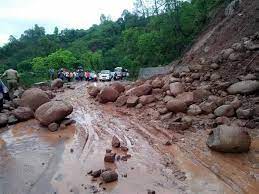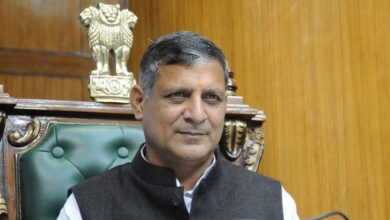India’s Unsciene Boom Is Symbolized by IIT Mandi’s Director
Laxmidhar Behera, the Director of the Indian Institute of Technology (IIT), Mandi, addressed a gathering of students in an auditorium and said, “So, what do you need to do to become a good human being?” To quit eating meat, he personally replied.
He then had pupils publicly swear they would never eat meat, claiming that doing so caused natural calamities. He introduced a rather unscientific viewpoint while adorning his speech with scientific jargon.
If the innocent animals are not prevented from being killed, Himachal Pradesh would suffer a serious setback. You are slaughtering those defenseless creatures. You can’t see it today, but there is a symbiotic link between it and the environmental destruction. It possesses. The large-scale landslide and several other phenomena, such as the recurrent cloudbursts, are all results of this cruelty, he claims in a video clip that quickly became popular on social media.
This was added to India’s list of unscientific statements that have been supported by scientists in positions of authority.
In the state of Himachal, construction projects have destroyed hundreds of hectares of forest, hydropower dams have impeded river flow, and the danger of landslides and ground subsidence is said to have grown as a result of growing concrete infrastructure and motorways. Things have only become worse as a result of climatic changes, which have raised the dangers of cloudbursts and potential glacial lake outburst floods.
As a consequence, during the last several years, there have been more and more voices raising concerns about the manner of growth. Environmentalists, scientists, and locals have consistently urged new consideration of major infrastructure projects in this vulnerable area. Additionally, scientists are working to develop solutions to the situation.
For Behera, the answer is straightforward. He urged the children to declare that they would not eat meat three times, each time louder than the last.
Vegetarianism is promoted by a variety of global religions and societal ideologies. The benefits or drawbacks of any eating behavior are not the focus of this article. This is about using a scientific institution’s platform improperly to propagate ideas that are unrelated to science.
Behera’s remarks are a despicable approach to impose one’s own eating habits on young children from various origins in addition to being an effort to downplay the negative impacts of government programs. Additionally, it is an insult to the scientists and researchers working at his own institution to develop early warning systems for water-triggered landslides and improved ways for mapping landslide susceptibility for better prediction.
Research and development connected to natural catastrophes is one of the ongoing scientific initiatives at IIT Mandi, with a financial assistance of at least Rs 3.4 crore.
Are his remarks sufficient justification for the IIT Mandi’s decision to support research on the geotechnical and hydrological elements of how climatic changes affect the danger of landslides in the Himalayan area with Rs 15 lakh each? The development of a low-cost, micro-electro-mechanical system (MEMS)-based early warning and monitoring system for rainfall-induced landslides is being funded with Rs 40 lakh by the Department of Science and Technology of the Union government.
In order to develop and implement low-cost landslide monitoring technologies in the Kangra district, an IIT Mandi project has been given Rs 50 lakh by the District Disaster Management Authority (DDMA) of Kangra. For a probabilistic multi-hazard study of earthquake and earthquake-induced landslides with relation to Shimla, Mandi, and Manali, ISRO has given scientists at IIT Mandi Rs 40 lakh.
With a budget of Rs 74.5 lakh, the Asia Pacific Network for Global Change Research is supporting research to better understand the effects of monsoon variability and compound extremes.
The DDMA of Mandi is contributing Rs. 55.88 lakh toward the creation of a remote sensing data-enabled landslide response system and Rs. 49.2 lakh for the deployment of low-cost landslide monitoring and warning systems.
Asking him why so much money is being spent on research that Behera himself deems pointless would be pointless.
However, his situation is hardly unique. On the stage of the Indian Science Congress in 2019, the vice chancellor of Andhra University, Gollapalli Nageswara Rao, said that the Mahabharata epic was evidence of ancient India’s understanding of in vitro fertilization and stem cells. An Indian Space Research Organisation (ISRO) helmsman said earlier this year that Vedic people were skilled in the construction of airplanes.
Additionally, cow science is the newest kid on the block. IIT Bombay scientists said that curd prepared from milk from cows of the pure Indian breed is healthier. A comprehensive national symposium on cow science was held at IIT Guwahati. The Department of Science and Technology provided funding to IIT Palakkad for the purpose of ‘Scientific Utilization via Research Augmentation – Prime Products from Indigenous Cows’.
These advancements as well as the cow science curriculum that the University Grants Commission (UGC) disseminated in 2021 may have served as inspiration for Behera. The UGC had encouraged all colleges and institutions in the nation to “encourage” their students to participate in the “Kamdhenu Gau Vigyan Prachar-Prasar Examination,” which was open to everyone, including the general public.
Its curriculum featured a chapter titled “Cow Slaughter, Catastrophes, and Earthquakes-An Interrelationship,” which linked the Vedic “laws of Karma” with the laws of gravity and “every action has an equal and opposite reaction.”
Scientists M. M. Bajaj, Ibrahim, and Vijayraj Singh, according to the chapter, “have proposed the theory that animal slaughter and natural calamities like earthquakes have an interrelationship.” “Large-scale abattoir activity as the causal agent for major earthquakes,” is the hypothesis put forward.
“Science still lacks adequate explanations for why earthquakes occur and how they may be predicted with fair precision, so their idea makes for a fascinating read. According to the chapter in the curriculum, “This hypothesis is being lauded for addressing the gaps in the study of seismology, which is yet a newborn field.
The syllabus went on to say that the theory “critically examines” the “origin of earthquakes due to the interaction of nociception waves (the waves generated by the animals on the verge of being butchered) with gravity waves,” which is even more absurd.
This “nociception” wave is said to have an effect on the splitting of the “shear wave,” which is connected to the “seismic anisotropy.” It said that “this splitting is related to stress-aligned crustal cracks.”
Scientists may be perplexed by this imaginative fusion of imagination and seismological terminology, unable to know whether to laugh, cry, get agitated, or be delighted.
If slaughterhouses are the cause of earthquakes, then why did Gujarat, one of India’s states with a large vegetarian population, record one of the country’s deadliest earthquakes? Or how destructive would the noise be from drilling and blasting mountains for the construction of massive infrastructure if the sound of killing animals can affect the earth’s crust and tectonic plates, which are located far below the surface of the planet?
But Behera and others of his caliber are unlikely to be interested in such queries. The superstitious among the scientists have reportedly seen opportunities for making huge strides in their careers when ruling party politicians of all stripes—from Prime Minister Narendra Modi to ministers in the Union and state governments—have made a series of unscientific claims, such as Lord Ganesha being proof of plastic surgery in ancient India and desi (indigenous) cow’s urine containing gold.
They don’t seem to care about the veracity of their statements or anything else for that matter; they just seem too eager to be the right person at the right moment to sit in the right seats.







